Flowers exist to balance nature, to feed animals, and to make humans feel happy and at ease with their beautiful fragrance, colors, shapes, and forms (1).
Throughout the evolution of our species, flowers have always been connected to our lives as well, as they help us to have a physical representation of how our inner feelings are like.
- What Are Heaths and Heathers?
- Facts About Heather Flowers
- What Are The Differences Between Heathers and Heaths?
- Propagation, Care, and Maintenance
- Growth Habits and Preferences of All the Heathers and Heaths
- Common Types of Heather and Heath Flowers
- Dark Beauty (Calluna vulgaris)
- Pat’s Gold (Calluna vulgaris)
- Jana (Calluna vulgaris)
- White Lawn (Calluna vulgaris)
- Spring Torch (Calluna vulgaris)
- Firefly (Calluna vulgaris 'Firefly')
- Alicia (Calluna vulgaris)
- Roswitha (Calluna vulgaris)
- Alexandra (Calluna vulgaris)
- Aphrodite (Calluna vulgaris)
- Kinlochruel (Calluna vulgaris)
- Goldsworth Crimson (Calluna vulgaris)
- Purple (Calluna vulgaris)
- Wickwar Flame (Calluna vulgaris)
- Anne Sparks (Erica carnea)
- Wintersonne (Erica carnea)
- Pink Spangle (Erica carnea)
- Bell’s Extra Special (Erica carnea)
- Foxhollow (Erica carnea)
- Challenger (Erica carnea)
- James Backhouse (Erica carnea)
- Myretoun Ruby (Erica carnea)
- Pirbright Rose (Erica carnea)
- Springwood White (Erica carnea)
- Red Jewel (Erica carnea)
- Carnea Aurea (Erica carnea)
- Eileen Porter (Erica carnea)
- Jennifer Anne (Erica carnea)
- Golden Starlet (Erica carnea)
- Praecox Ruby (Erica carnea)
- March Seedling (Erica carnea)
- Viking (Erica carnea)
- Snow Princess (Erica carnea)
- Westwood Yellow (Erica carnea)
- Vivelli (Erica carnea)
- Cecelia M. Beale (Erica carnea)
- Starlet (Erica carnea)
- Springwood Pink (Erica carnea)
- Ice Princess (Erica carnea)
- John Kampa (Erica carnea)
- Isabelle (Erica carnea)
- Loughrigg (Erica carnea)
- King George (Erica carnea)
- Prince of Wales (Erica carnea)
- Orient (Erica carnea)
- R. B Cook (Erica carnea)
- Rosalie (Erica carnea)
- Snow Storm (Erica carnea)
- Rosantha (Erica carnea)
- Ruby Glow (Erica carnea)
- Irish Heath (Erica erigena)
- Cornish Heath (Erica vagans)
- Darley Dale Heath (Erica x darleyensis)
- Bell Heather (Erica cinerea)
- Velvet Night (Erica cinerea)
- Pink Star (Erica tetralix)
- Which Of These Different Types of Heathers and Heaths Will You Grow?
Therefore, through flowers, we can express some of the deepest emotions that we are continuously feeling.
What Are Heaths and Heathers?
The Heather flower is a small flower that is often used as a decorative plant in balconies, terraces, and gardens. But it can also be planted in the garden, of course.
It has vibrant colors that make you enjoy the spaces where you see her even more. She is often referred to as the Queen of Winter because Heather flowers also bloom during this time of the year, and thanks to their strength they can survive the snow and or any other type of hard climate conditions.
Heather flowers have at least 800 varieties that are known, and they can be found all over the world, but it has proven to be a very difficult plant of study, due to the numerous amounts of types, subtypes, and subdivisions that are associated with this plant (2).
However, they are most likely located in the African continent, in Europe, and in North America.
In this article, you will learn everything you need to know about Heather flowers: from the most basic facts, to how to take care of them, and what they are good for.
Continue reading if you would like to understand how Heather flowers are good for you and for the ecosystem that surrounds you.
Facts About Heather Flowers
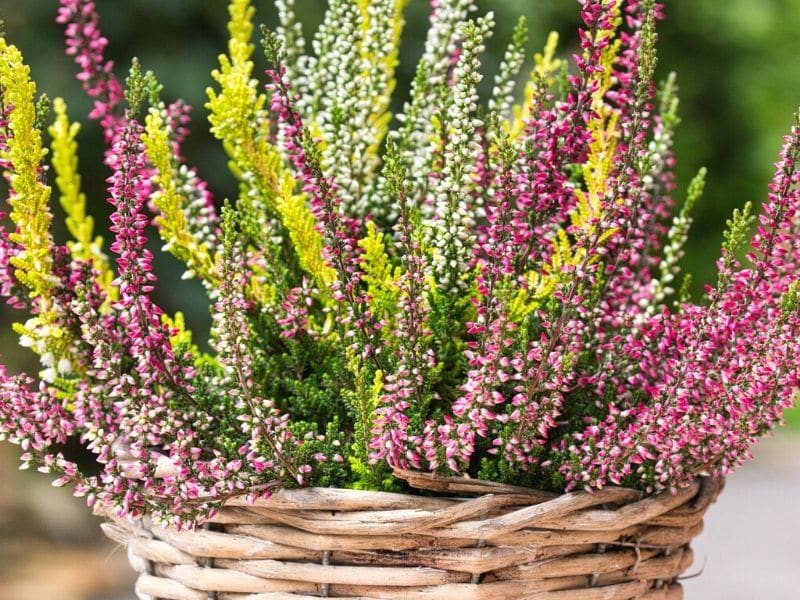
- Heather flowers come from the Family of plants Ericaceae (3).
- They are considered to be dwarf shrubs and cannot grow that tall (4).
- Heather flowers come from the genus Calluna vulgaris (and are sometimes referred to as ling heather) whereas, Heath flowers come from the genus, Erica.
- The word Calluna comes from a Greek word that means ‘’to purify’’, and the word Vulgaris comes from Latin and it means ‘’common’’.
- The meaning of heather flowers includes luck, strength and admiration, depending on the color, according to the Heather Society.
- Both the genus Calluna vulgaris and Erica types of flowers are native to Europe and South Asia, but they can also be found in some parts of North America, Turkey, and Morocco (5).
- Even though they prefer to grow on the mountains’ cliffs, they also thrive in sandy and rocky soils.
- The English name of Heather comes from an old English word ‘’hather’’. This meant that it was a field that was full of beautiful and striking flowers.
- Also, this flower has been used in rural populations and in poor regions in order to make many items, such as brooms, roofs, bedding, and baskets.
- Each heather flower can have up to 30 seeds, so this also means that they can easily propagate (6). They are also quite winter hardy and deer resistant.
So, when talking about Heather flowers one is mentioning and grouping two genera of plants which are the Heathers and the Heaths, even though they both come from the same Ericaceae family.
Therefore, because they are two different subtypes they are also botanically different, and this can be seen in the ways that the Calluna genus and the Erica genus grow.
What Are The Differences Between Heathers and Heaths?

The main similarity is that they are both from the family Ericaceae of plants (7).
However, a Heath plant is derived from the genus of Erica, which has at least 500 species under its classification, and, on the other hand, the Heather plant is derived from the species of Calluna, which doesn’t have as many subspecies.
In this article, we are going to talk about both Heather flowers and Heath flowers.
Heather plants
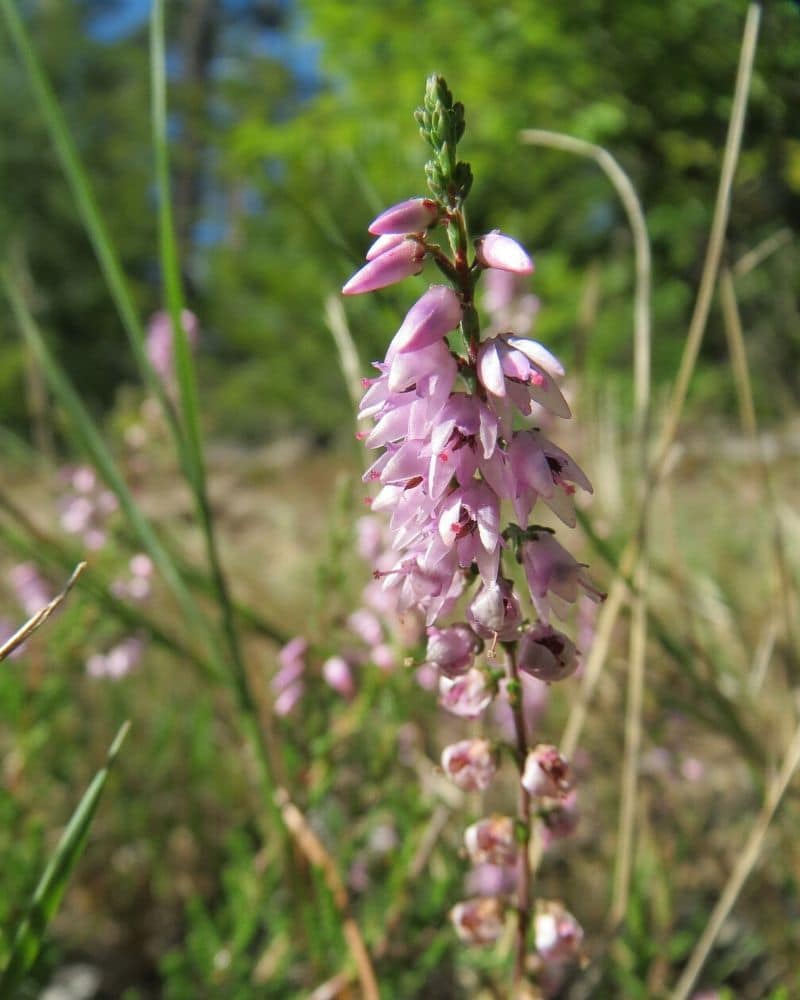
They come from the Calluna genus. They are very easy to grow and maintain, but you must make sure the right conditions are met for them to feel comfortable to grow. They prefer acidic soils.
If you don’t have acid or slightly acid soils, you can amend the soil and encourage new growth by adding things like peat moss or pine needles. This will ensure gorgeous evergreen foliage color and help the plant reach its true mature width.
Heaths plants
They come from the Erica genus. They are often called the winter Heathers as they tend to thrive in colder climates. Unlike all the heathers, heaths are great for cold weather and look the most beautiful (with deep green leaves) in the winter months, as compared to those with a summer blooming season.
Also, their foliage seems to be longer than the Calluna plants. They are also hardy plants that, in general, are more drought tolerant and can handle a wider soil pH range.
Propagation, Care, and Maintenance
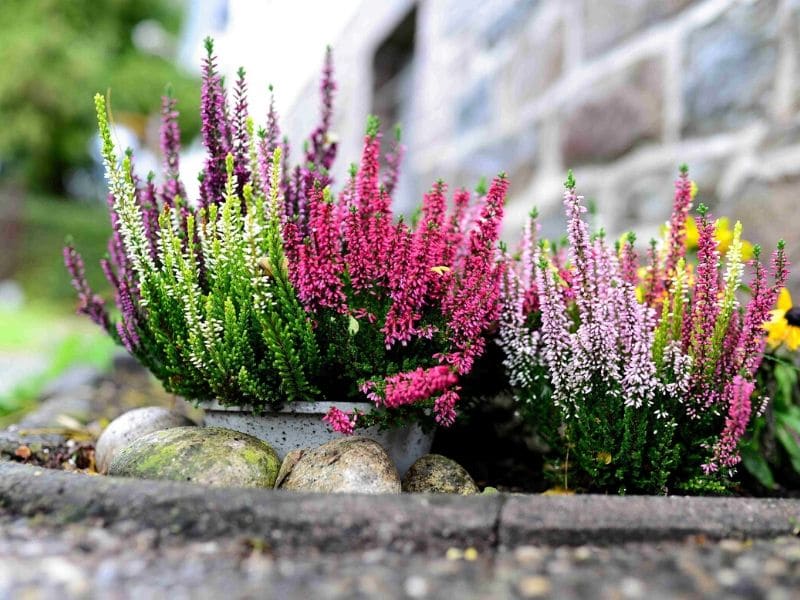
Heather plants are very strong, so they only require little maintenance on your behalf to keep them healthy. If you are buying either Heather or Heath plants, then you will need to plant them during Spring.
Make sure to water your plants thoroughly during the summer. If you already have Heather or Heath plants, then you should prune them each year, especially after they have finished flowering. This will help them grow stronger during the next year.
Growth Habits and Preferences of All the Heathers and Heaths
Rustic types of Heather plants can be found in cold areas, moors, and chalky cliffs. And, in addition to its adaptability to different and harsh conditions, they also help reduce the atmospheric pollution of the place they are in (8).
Some Heather plants like to have compost in their soil, but only do this when you start planting them. They also need to be water thoroughly when they are growing, but try not to overwater them. Well drained soil is ideal.
In addition, don’t forget that your soil must be acidic if you are planting some summer Heathers, and it needs to be either neutral soil, alkaline soils, or acidic soil for some winter Heathers.
It’s important to pay attention to the growing requirements of all the heathers and heaths you are considering to make sure you can provide the acidic or alkaline soils your variety prefers as well as the right sun exposure
Some varieties are hardy all over, while others only handle certain USDA zones. Similarly, some can handle salt spray and pollutants, while others can’t. Do your research!
They grow slowly, so if you don’t have much patience then this plant is not for you!
So, how can you get the best from your Heather plant? Continue reading and find out. These tips can be followed for several varieties of both winter heath and heather alike.
Common Types of Heather and Heath Flowers
There are – at least – three subtypes of Heather flowers: Calluna vulgaris, the genus Erica, and Daboecia. The Erica type can be found in parts of Africa, Russia, and Europe.
The Calluna type can be found in the wilderness in Europe, North America, and Southern Asia. And the Daboecia type can be found mainly in Ireland.
Some of these can be tough to find locally, especially if you don’t have a nearby heath or heathers nursery. The good news is that most can be purchased via mail order.
Here are the most common types of Heather and Heath flowers that belong to the Calluna vulgaris and Erica spp. subtype:
Dark Beauty (Calluna vulgaris)

This type of plant has semi-double flowers that can be a ruby-red color. They also last for a very long time, and they can grow up to 8 inches high. They are one of the easiest types to grow due to its low maintenance (9).
Hummingbirds and butterflies love Dark Beauty Heather flowers as they can feed very well with them. They prefer well-drained soils, and they enjoy being exposed to the full sun.
Pat’s Gold (Calluna vulgaris)
It has yellow orange flowers and bright green-golden foliage. It blooms in August, however, the flowers will last throughout the winter. Prune the needle like leaves often for good air circulation and the most dense growth.
Jana (Calluna vulgaris)
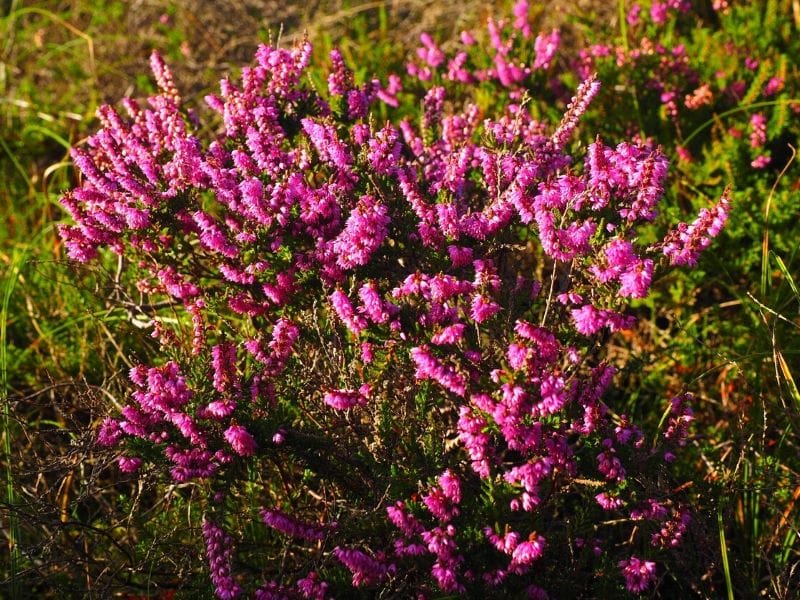
Here’s another heath or heather type to include in your garden design!
It prefers acidic soil. They have dark-pink blooms that cluster together, thus they tend to need a lot of space. They also bloom profusely. There are several types of Jana flowers, and depending on which one you choose to plant, their soil needs will also change.
White Lawn (Calluna vulgaris)
They tend to grow flat on the ground. They bloom from August to September, into the late summer to early fall, so they need to avoid winter. It has white flowers and green foliage.
Spring Torch (Calluna vulgaris)
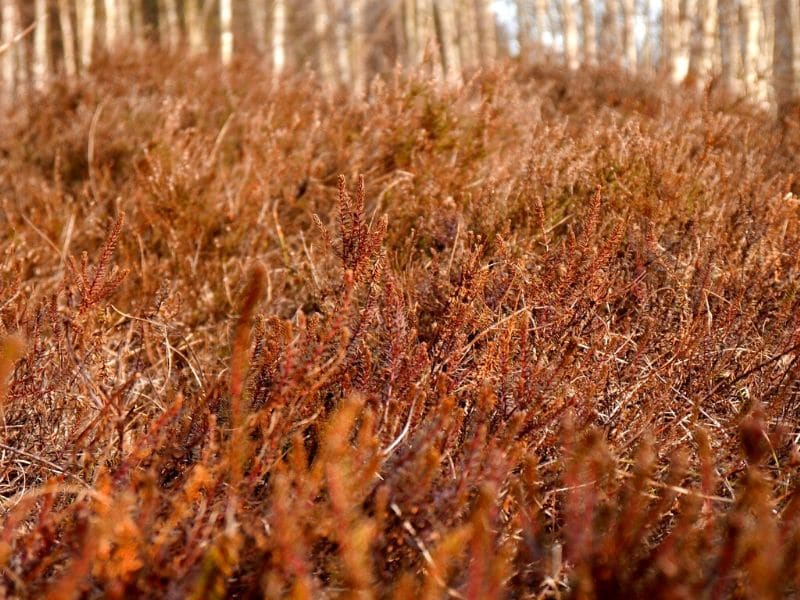
One of the most interesting facts about this type of Heather is the fact that its petals change colors depending on what season they are in. Also, even though its leaves are green, they have tips of different colors, such as yellow, pink, and red. They can grow up to 14 inches in height and are very tolerant to dry climates. However, they should be avoided in places where strong winds are the norm.
Firefly (Calluna vulgaris ‘Firefly’)
This type of Calluna vulgaris is also known as the Scottish Heather flower. It has mauve and red petals although they also change colors throughout the seasons. It loves to show off because of its grandness. It can grow up to 20 inches in height. Hummingbirds and butterflies are attracted to these plants. They also look great in vases and containers, in case you would like to put some inside of your house.
Alicia (Calluna vulgaris)
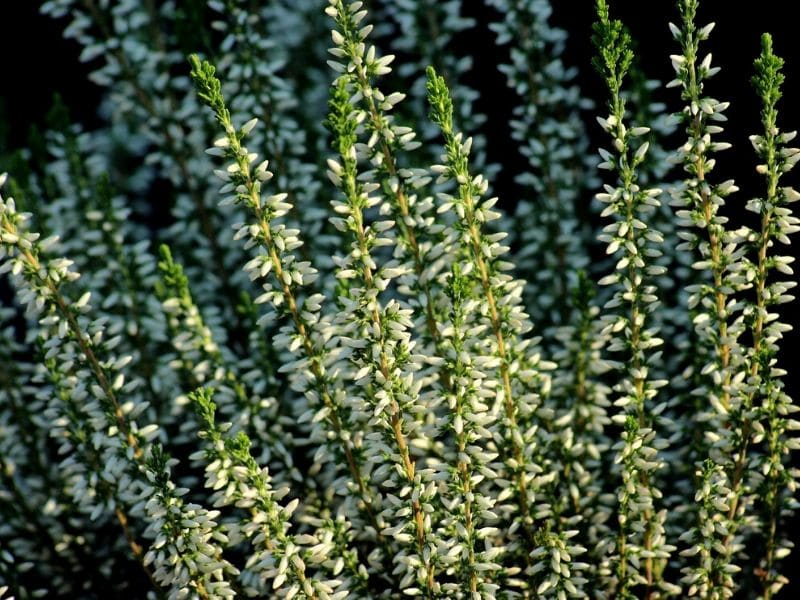
Another shrub, this type of Heather can grow up to 28 inches in height. Its flowers are pink, and it thrives better when placed directly under the sun.
Roswitha (Calluna vulgaris)
Even though it doesn’t have many petals it still flowers from September to January. The flower buds, when visible, are lilac, red, and or pink.
Alexandra (Calluna vulgaris)
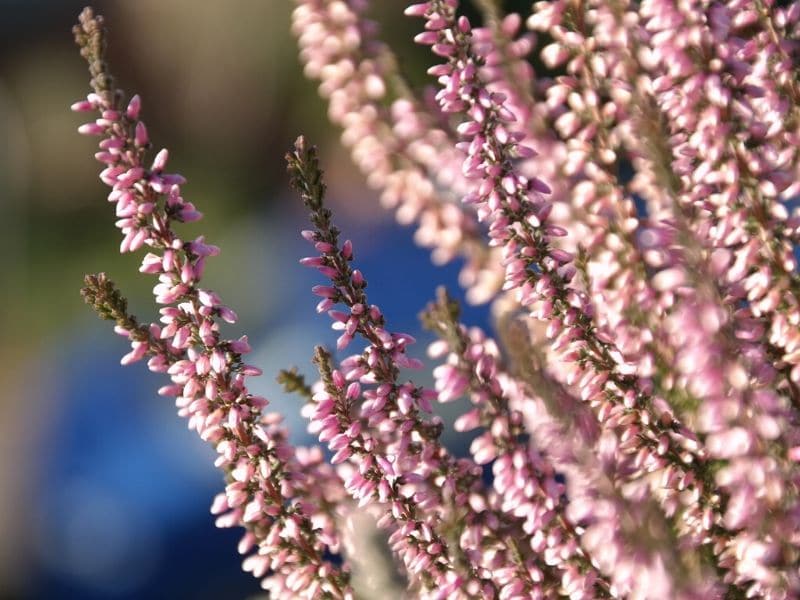
It can grow up to 25 inches tall. It has bright pink and white petals. It also prefers acidic soils, which is where they thrive the best.
Aphrodite (Calluna vulgaris)
It has bright red petals and dark green foliage. They can grow up to 12 inches in height, and prefer to be fully exposed to the sun. They are very easy to grow, and also prefer acidic soil. They need to be pruned yearly.
Kinlochruel (Calluna vulgaris)
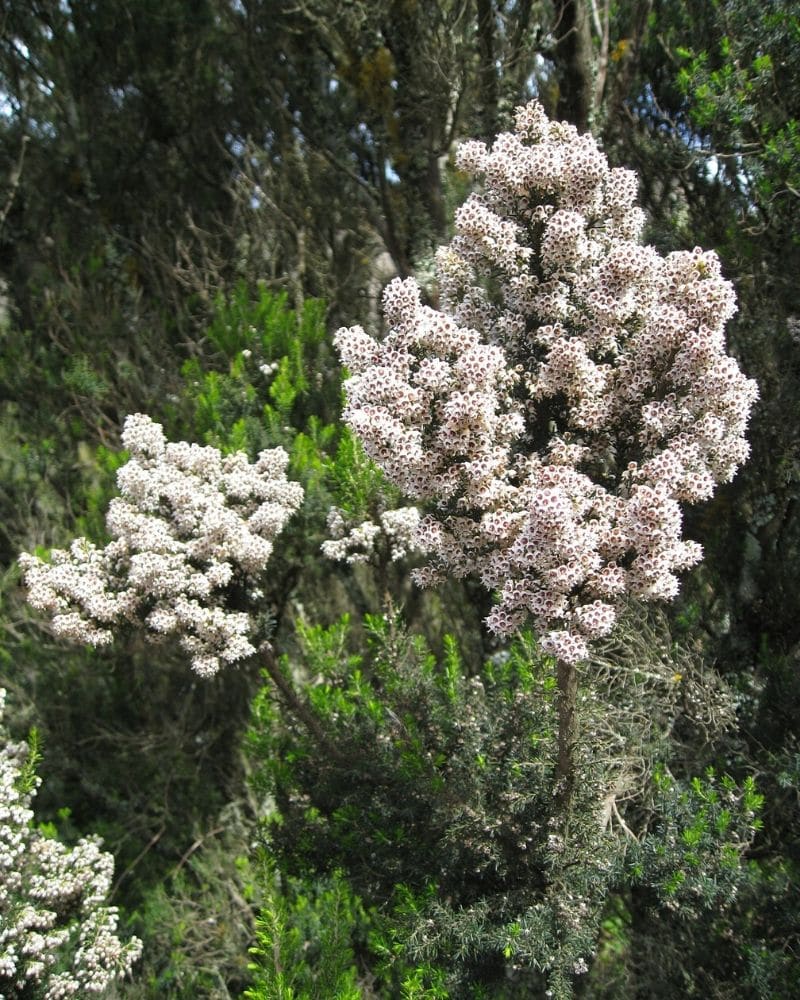
It has white and double flowers, which makes them one of the only two types of Heathers with this characteristic. They bloom from August to October and it’s very beautiful.
Goldsworth Crimson (Calluna vulgaris)
They bloom from September to November. It has dark green foliage and is very short, only growing up to five inches in height. They need to be pruned each year.
Purple (Calluna vulgaris)
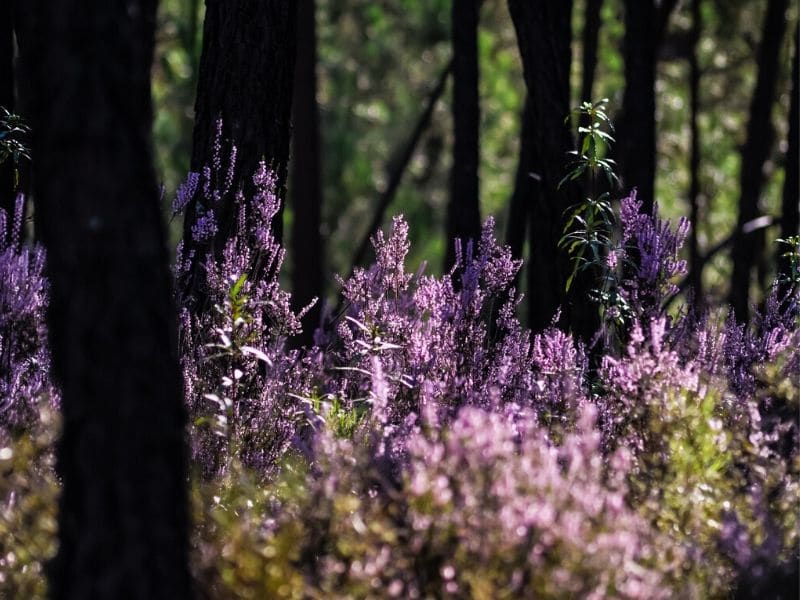
One of the most beautiful Heather flowers, this type of plant has a very bright green stem which brings a stark contrast to its purple petals. It can grow up to 28 inches in height and will bloom twice throughout the year.
Wickwar Flame (Calluna vulgaris)
It can grow throughout the year. It is a small evergreen shrub that has yellow and orange foliage during the summer. These colors change during winter, and they become red. They can grow up to 15 inches tall, and prefer to be exposed under direct sunlight (10).
Anne Sparks (Erica carnea)
It has bright pink flowers and red foliage. It can grow up to six inches in height, and it usually only blooms once during the year. It prefers to be under a shadow and not directly exposed to the sun.
Wintersonne (Erica carnea)

Its flowers are lilac, however, they turn magenta once they become older. It can grow up to six inches high, and they only bloom once a year. They thrive in acidic soil.
Pink Spangle (Erica carnea)

Its flowers are bright pink and they have a unique shape because they are tubular. They can grow up to six inches in height. Their pink flowers tend to get darker as they age.
Bell’s Extra Special (Erica carnea)
As its name suggests, this type of plant is beautiful because it is so special. You have probably never seen anything like it: it has heliotrope flowers, which means that they are very fragrant. In fact, most dogs and cats can be attracted to its smell, however, they are also poisonous to them. It can grow up to six inches in height, and it has very bright purple-pink petals.
Foxhollow (Erica carnea)

Its petals are pink or yellow and its foliage has a very dark green tint to it. However, this foliage will get darker during winter. It can grow up to 10 inches in height.
Challenger (Erica carnea)
It’s a very interesting type of flower, as it blooms in a very bright red. It can grow up to seven inches in height, and it tends to bloom once a year, from January to April. Challenger has pink flowers.
James Backhouse (Erica carnea)
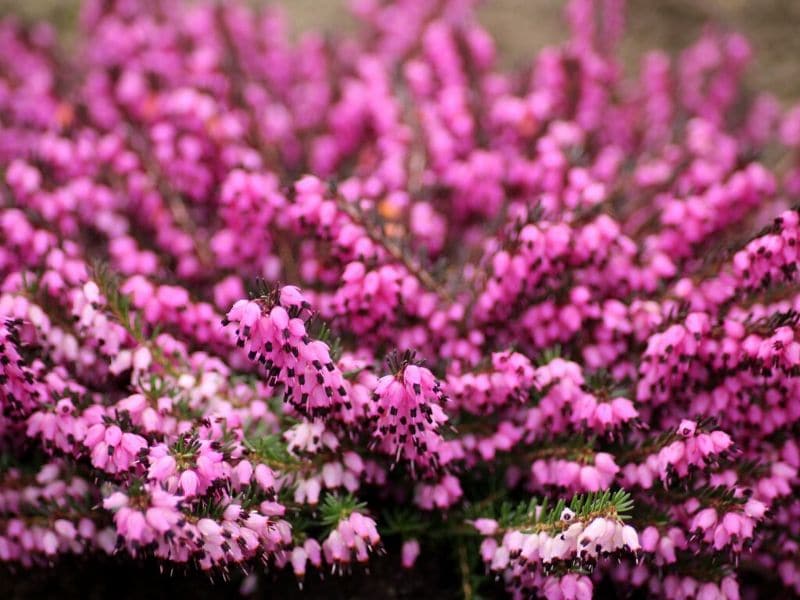
It has large flowers that are lavender. They grow up to six inches high, and they are late bloomers.
Myretoun Ruby (Erica carnea)
It also has heliotrope flowers. They are pink-purple in color. They can grow up to eight inches in height, and they can be seen until May.
Pirbright Rose (Erica carnea)
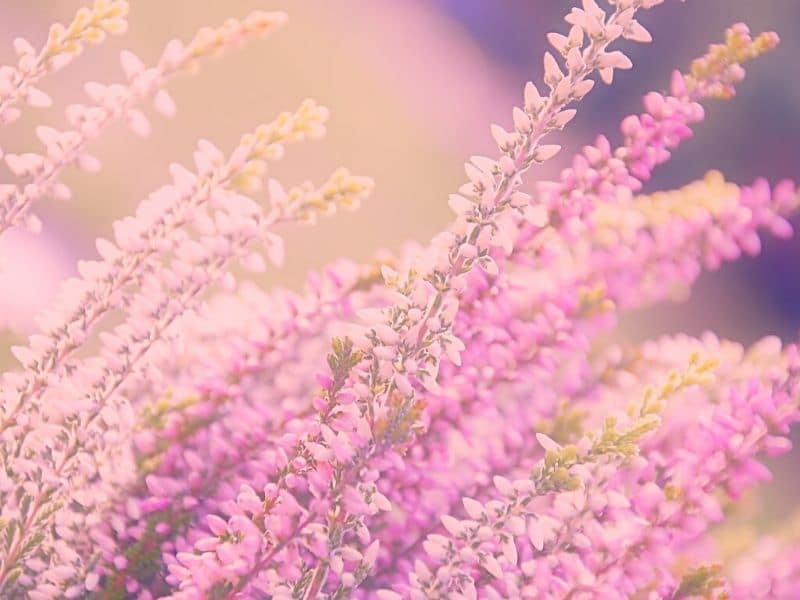
A stunning type of flower, it has lilac and pink petals. They are very elegant and are one of the most unique types of Heather plants. They can grow up to eight inches in height.
Springwood White (Erica carnea)
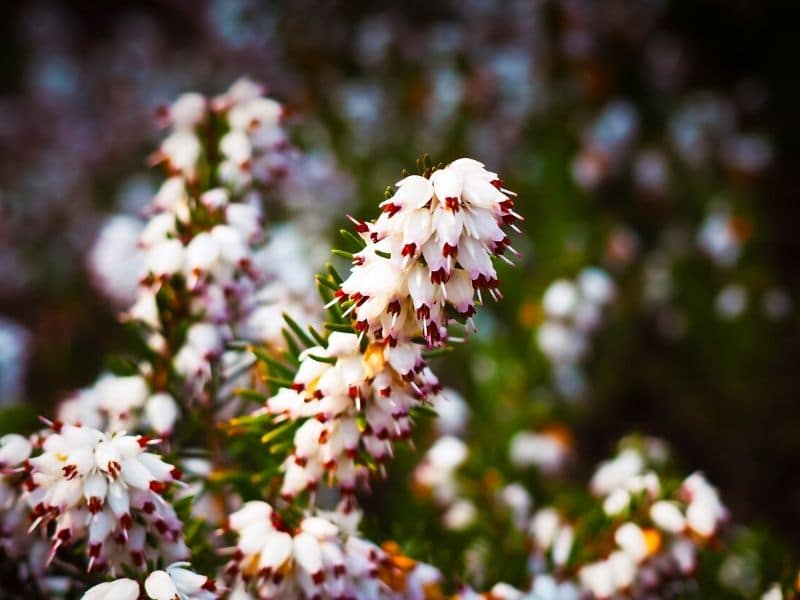
Another tall type of Heather plants can grow up to 10 inches in height. They have white petals and can bloom up until May. Springwood whites prefer acidic soils in order to thrive.
Red Jewel (Erica carnea)
They have flowers that are beet-red in color. They can only reach up to six inches in height. In addition, they are one of the earliest Heaths to bloom, this is why they are also called December Red.
Carnea Aurea (Erica carnea)
They tend to bloom from January to April. This type of Heath can grow up to six inches high. Its flowers are pale pink, and they have gold-yellowish foliage. They need free-draining soils that will help them achieve their perfect size and health.
Eileen Porter (Erica carnea)
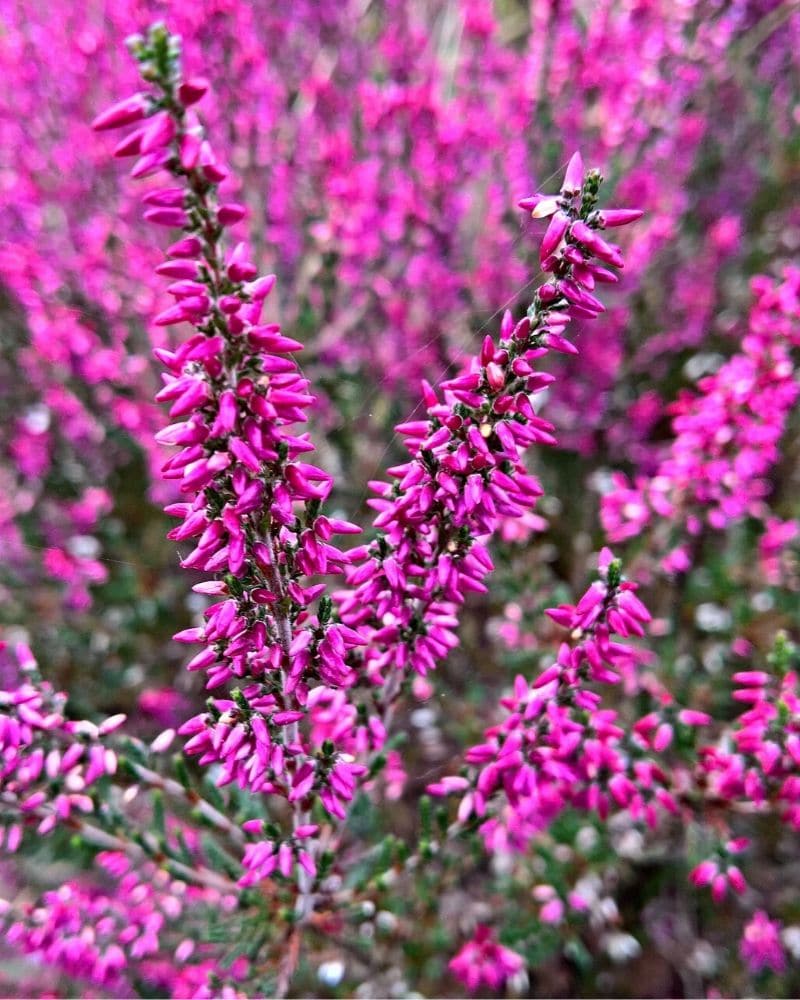
It blooms from October to April, which makes her one of the first-bloomers of her family. She is a striking plant that can grow up to six inches in height. Its flowers are red and/or carmine colored.
Jennifer Anne (Erica carnea)
It blooms from November to April. They love acidic, well-drained soils. They have pink flowers that tend to go darker once they start aging. They provide nectar and pollen for bees, thus they are truly important in any ecosystem.
Golden Starlet (Erica carnea)
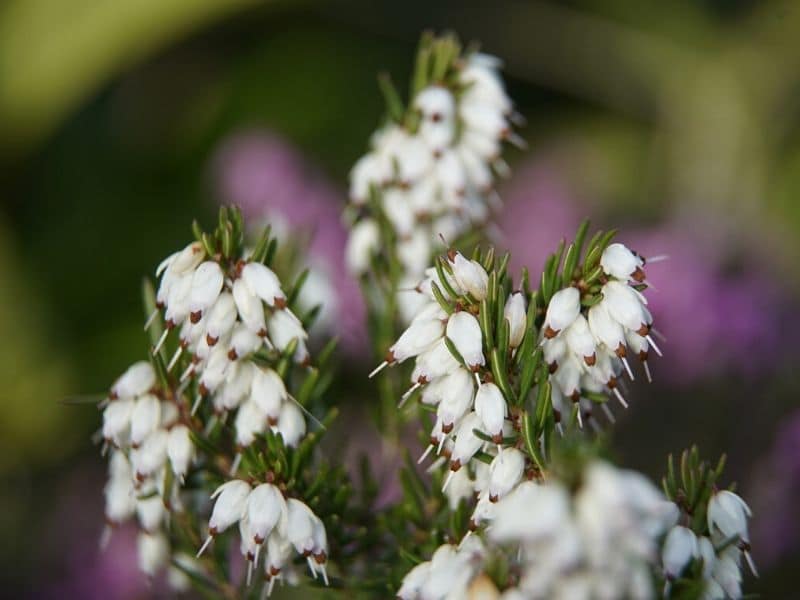
One of the loveliest Heaths out in nature, this type of flower has golden foliage and white petals that have an orange tint to them. They bloom from late-December to March. They can only grow up to eight inches in height.
Praecox Ruby (Erica carnea)
One of the most interesting-looking flowers, their petals are deep-lilac and very dark pink. They can grow up to ten inches in height. They are very eye-catching and beautiful. They also tend to bloom throughout a long time, if their basic survival conditions are met.
March Seedling (Erica carnea)
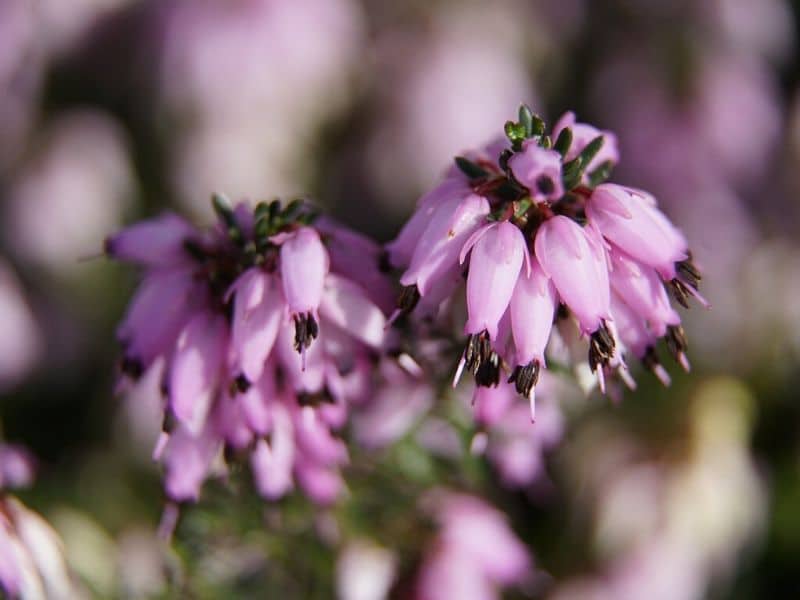
It can reach up to 12 inches in height, making it one of the tallest Heather plants. They also have purple and pink petals, but they are very light in comparison to other types.
Viking (Erica carnea)
These flowers grow up to ten inches in height. They have deep-purple and dark-red flowers, which are very eye-catching. They are one of the shortest-bloomers, as they can only be seen in March and April.
Snow Princess (Erica carnea)

They are called this because they bloom from December to May and because their flowers are pure white. They are relatively small and can only grow up to six inches in height.
Westwood Yellow (Erica carnea)
They bloom from February to April, when temperatures are high. They can grow up to six inches in height and have yellow-gold foliage. Its flowers are pink.
Vivelli (Erica carnea)
They bloom from January to May. This plant has flowers that have a carmine-dark red color, whereas its foliage is bronze-green. They thrive in semi-dry soil.
Cecelia M. Beale (Erica carnea)
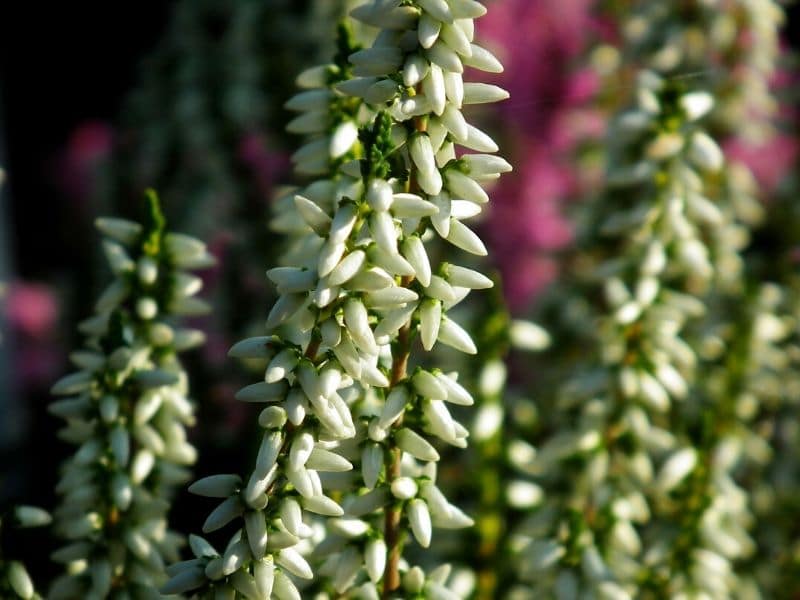
They can grow up to six inches in height. They are very beautiful Heaths that have white flowers and dark green foliage. They bloom from January to April and prefer acidic soil, which is where they thrive the best.
Starlet (Erica carnea)
They can grow up to eight inches in height. They have coral-pink petals and very bright green foliage. Their blooming period is short and they can only be seen in February and March.
Springwood Pink (Erica carnea)
They can grow up to ten inches in height. They bloom from December to May and are one of the longest blooming Heaths. They have pink flowers.
Ice Princess (Erica carnea)
They have white flowers with an orange and golden tint to them. Even though they seem tall they can only grow up to six inches in height. They bloom from February to April.
John Kampa (Erica carnea)
Its flowers are very pale-pink. They bloom from February to April and prefer to be exposed under direct sunlight, where they reach their highest-peak health. They can grow up to six inches in height and can propagate fairly easily.
Isabelle (Erica carnea)
They are very short and can only grow up to five inches in height, however, they bloom from November to May which is a very long time. They have white flowers and bright green foliage.
Loughrigg (Erica carnea)
They are one of the shortest Heaths in nature as they grow from three inches to six inches in height. They bloom from January to May. They have pink flowers and vibrant green foliage.
King George (Erica carnea)
They can grow up to eight inches high. They have deep-pink petals that are very bright. They bloom from December to April and are very easy to propagate.
Prince of Wales (Erica carnea)
Its flowers resemble a shell. They have pink flowers and bloom from November to April. They catch everybody’s attention because they are truly stunning. They can grow up to eight inches high.
Orient (Erica carnea)
They can only grow up to six inches in height. They have lilac and pink flowers with dark green foliage colors. They can bloom from February to April and can stand harsh weather conditions.
R. B Cook (Erica carnea)
They bloom from December to April, but they prefer colder climates compared to others that aren’t in this same variety. They can grow up to eight inches in height. Its flowers have a lavender color and they are very fragrant. These winter bloomers also have good foliage growth and excellent winter hardiness, as you might expect!
Rosalie (Erica carnea)
It blooms from January to May. They can grow up to ten inches in height and have soft pink flowers with very dark green foliage. They thrive better in acidic soils.
Snow Storm (Erica carnea)
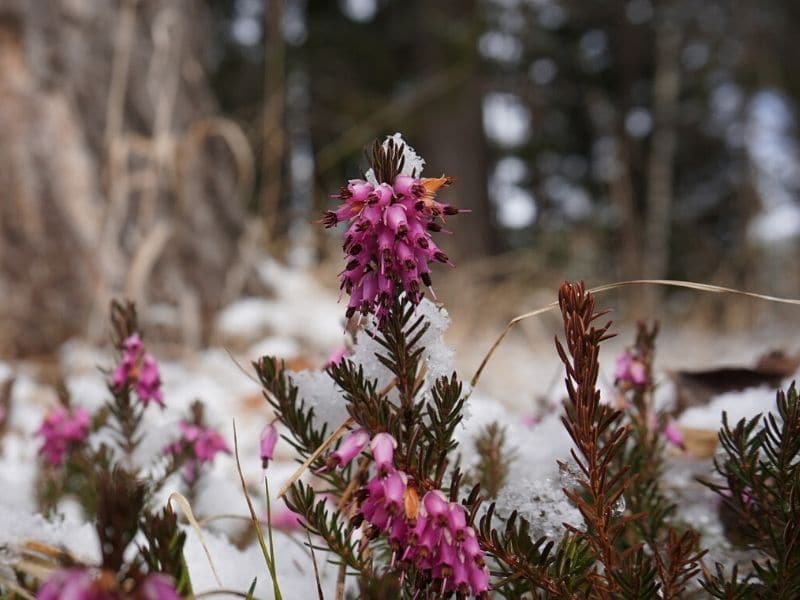
Another type of Heath flower that can stand cold climates and harsh weather conditions. This plant has abundant white and pink flowers and can grow up to ten inches in height. They bloom from December to March, which is usually the coldest months in the Northern Hemisphere.
Rosantha (Erica carnea)
It only blooms in March and April but there’s no doubt that its flowers are very eye-catching. They have dark pink flowers and can grow up to six inches in height. As is the case with other varieties of these acid loving plants, this one likes well drained soil with decent drainage.
Ruby Glow (Erica carnea)
As its name suggests, its flowers are ruby and red. They are relatively small and can only grow up to six inches in height. They bloom from January to May, which makes them resistant to cold climates.
There are also these other types of Erica flowers that belong to the same family:
Irish Heath (Erica erigena)
Irish Heath, which goes by the scientific name Erica erigena, is a hybrid plant that originated in Ireland. It features pale pink flowers that bloom in late autumn or early winter, making it a versatile choice for the colder months.
Irish Heath grows well in well-drained soil and prefers full sun or partial shade. Afternoon shade is best.
Cornish Heath (Erica vagans)
Cornish Heath, also known as Erica vagans, is native to Cornwall in the UK. It features striking pink flowers that bloom in the summer months, with these colorful flowers attracting bees and other pollinators to your garden. Cornish Heath grows best in acidic soil and full sun or dappled shade.
Remember, full sun to partial shade makes the plant grow the best and most dense growth, so do your best to provide at least only part shade rather than full.
Darley Dale Heath (Erica x darleyensis)
Another popular choice is Darley Dale Heath, a hybrid plant that was created by crossing Cornish and Portuguese Heath species. It blooms in a range of colors, including pink, white and red, and grows well in well-drained soil and full sun or partial shade.
Bell Heather (Erica cinerea)
Bell Heather, or Erica cinerea, is a compact shrub that features pink or purple flowers that bloom in summer. It is well-suited to rocky or sandy soils and prefers full sun or dappled shade.
Velvet Night (Erica cinerea)
It’s another type of Heather. It has black and purple flower colors and very dark-green foliage. It can bloom throughout the year. They do have to be pruned a lot, but they are very beautiful evergreen plants. It’s often used as a medicine in many parts of the world (11).
Pink Star (Erica tetralix)
They bloom from May to October. They have pink blooms and green foliage. They prefer warmer climates and need to be exposed under direct sunlight. Very easy to maintain as they only need to be pruned once each year, however, they are slowly disappearing nowadays (12).
Which Of These Different Types of Heathers and Heaths Will You Grow?
As you can see, there are dozens of different types of heathers and heaths you can grow, many of which are low maintenance and some of which provide year round color with varied bloom times – and can thrive in all kinds of growing conditions.
From Cornish heath to Irish heath, scotch heather and so much more, there’s lots to choose from. Whether you want a low growing variety or one that produces colored foliage, the options are endless.
Give these heathers and heaths a try today!
References
Reference List:
- Haviland-Jones, J., Rosario, H. H., Wilson, P., & McGuire, T. R. (2005). An Environmental Approach to Positive Emotion: Flowers. Evolutionary Psychology. https://doi.org/10.1177/147470490500300109
- Wrońska-Pilarek, D., Szkudlarz, P., & Bocianowski, J. (2018). Systematic importance of morphological features of pollen grains of species from Erica (Ericaceae) genus. PloS one, 13(10), e0204557. https://doi.org/10.1371/journal.pone.0204557
- Monschein, Marlene & Iglesias, Jacobo & Kunert, Olaf & Bucar, Franz. (2010). Phytochemistry of heather (Calluna vulgaris (L.) Hull) and its altitudinal alteration. Phytochemistry Reviews. 9. 205-215. 10.1007/s11101-009-9153-5.
- Matthews, Robin F. 1993. Calluna vulgaris. In: Fire Effects Information System, [Online]. U.S. Department of Agriculture, Forest Service, Rocky Mountain Research Station, Fire Sciences Laboratory (Producer). Available: https://www.fs.fed.us/database/feis/plants/shrub/calvul/all.html [2020, March 24].
- Behrend, A., Borchert, T., Spiller, M., & Hohe, A. (2013). AFLP-based genetic mapping of the “bud-flowering” trait in heather (Calluna vulgaris). BMC genetics, 14, 64. https://doi.org/10.1186/1471-2156-14-64
- Borchert, T., Eckardt, K., Fuchs, J., Krüger, K., & Hohe, A. (2009). ‘Who’s who’ in two different flower types of Calluna vulgaris (Ericaceae): morphological and molecular analyses of flower organ identity. BMC plant biology, 9, 148. https://doi.org/10.1186/1471-2229-9-148
- Behrend, A., Borchert, T., & Hohe, A. (2015). “The usual suspects”- analysis of transcriptome sequences reveals deviating B gene activity in C. vulgaris bud bloomers. BMC plant biology, 15, 8. https://doi.org/10.1186/s12870-014-0407-z
- Spindelböck, J. P., Cook, Z., Daws, M. I., Heegaard, E., Måren, I. E., & Vandvik, V. (2013). Conditional cold avoidance drives between-population variation in germination behaviour in Calluna vulgaris. Annals of botany, 112(5), 801–810. https://doi.org/10.1093/aob/mct142
- Borchert, T., Krueger, J., & Hohe, A. (2008). Implementation of a model for identifying Essentially Derived Varieties in vegetatively propagated Calluna vulgaris varieties. BMC genetics, 9, 56. https://doi.org/10.1186/1471-2156-9-56
- Ídem.
- Aires, A., & Carvalho, R. (2017). Profiling of Polyphenol Composition and Antiradical Capacity of Erica cinerea. Antioxidants (Basel, Switzerland), 6(3), 72. https://doi.org/10.3390/antiox6030072
- Strandberg, M., Damgaard, C., Degn, H. J., Bak, J., & Nielsen, K. E. (2012). Evidence for acidification-driven ecosystem collapse of Danish Erica tetralix wet heathland. Ambio, 41(4), 393–401. https://doi.org/10.1007/s13280-012-0251-z
Close
*Photo by AngieC333/depositphotos







